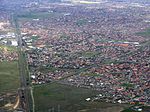Sunbury Pop Festival or Sunbury Rock Festival was an annual Australian rock music festival held on a 620-acre (2.5 km2) private farm between Sunbury and Diggers Rest, Victoria, which was staged on the Australia Day (26 January) long weekend from 1972 to 1975. It attracted up to 45,000 patrons and was promoted by Odessa Promotions, which was formed by a group of television professionals, including John Fowler, from GTV 9 Melbourne.
Although conceived and promoted as Australia's Woodstock, the Sunbury Pop Festivals signalled the end of the hippie peace movement of the late 1960s and the beginning of the reign of pub rock. The early festivals were financially successful and featured performances by Australian and New Zealand bands including, Billy Thorpe & the Aztecs, Max Merritt and the Meteors, Chain and Wild Cherries. Various live albums were recorded at the festivals including Aztecs Live! At Sunbury issued in September 1972, which peaked at No. 3 on the Go-Set Top 20 Albums; and the triple live album, Sunbury 1973 - The Great Australian Rock Festival which was the inaugural release by Mushroom Records.
Looking to pull in bigger crowds, the founders booked international acts with British rock band Queen performing in 1974. They arrived late, and were initially booed by a crowd who expected to see home grown acts, but they finished their set despite crowd screams of "go back to Pommyland, ya pooftahs". Lead singer Freddie Mercury retorted with "When we come back to Australia, Queen will be the biggest band in the world!". A fledgling Skyhooks were also booed and returned the following year with a new lead singer, Graeme "Shirley" Strachan. In 1975 another British band, Deep Purple, were head-liners. A fracas developed on-stage between Deep Purple's roadies and AC/DC's roadies and members. Due to poor weather and high ticket prices the attendance was down to 16,000. Odessa Promotions was liquidated after paying out Deep Purple but most local acts were not paid by Odessa. Late in the year, Deep Purple placed money into a fund so that unpaid artists were paid at the full musician's rate.
In 2015, the Sunbury Pop Festival was inducted into the Music Victoria Hall of Fame.There is footage on YouTube about the Sunbury Rock festival .










